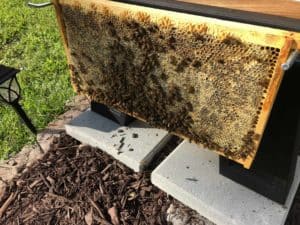Freezing honey frames is a useful option for the beekeeper
After the beekeeper extracted honey from supers, the work isn’t quite done yet. The beekeeper will need to bottle that honey, clean up the extracting equipment and then decide what to do with those “wet” honey frames.

As honey does not spoil, you may think it’s OK to simply toss these frames in a corner until next spring. However, there is one looming threat with this approach – wax moths. The greater and lesser wax moths are both common in the United States and can ruin comb in short order. Luckily this pest has a chink in its armor, namely freezing temperatures.
If you live in a colder region of the country, where winter temperatures are frequently below freezing, you can store your frames outside if you have a mouse-proof location to do so. If not, however, you should freeze your frames for at least 24 hours in a freezer prior to storage. This will kill any wax moth eggs already laid in the comb. You’ll then need to store these frames in a moth-proof location. There are several commercially available products that beekeepers may apply to frames and comb, to protect from moths.
If you’ve just pulled your supers and don’t have time to extract quite yet, you can store your frames for a few days. Once the honey had been extracted, freezing is suggested, after which many beekeepers will place these frames back in the hive for the bees to clean up prior to storage. Be careful to consider inadvertently attracting robbing and unwanted freeloaders, such as yellow jackets.
An important benefit of storing honey-laden frames, favored by many beekeepers, is the possibility of providing to weaker colonies in the spring, if necessary.
While there are many variations to the approach, keeping some spare space in your freezer for this is a good idea. Consider this before you put on that bee suit and head out to the apiary to pull those supers for harvest.
